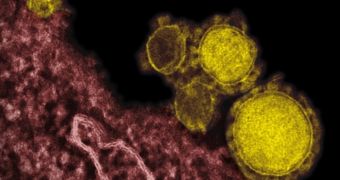A team of investigators from the University of Iowa, led by microbiologist Stanley Perlman, announces the development of a mouse model for a condition known as Middle East respiratory syndrome (MERS). This virus has thus far killed 77 out of 180 people it infected, a 42 percent mortality rate.
MERS is caused by a coronavirus, scientists say. An outbreak has occurred recently in Saudi Arabia that gave the virus ample opportunity to display its deadliness. Up until now, there has been no chance of a remedy in sight, but the development of mice that display the characteristics of the disease could represent a major step forward in this direction.
The University of Iowa team argues that the new mouse model can now be used for expediting drug and vaccine testing efforts, as well as for studying epidemic patterns in the tiny rodents. Results from such studies would have direct applicability on humans, too.
Previous attempts on decoding the traits of MERS have focused on monkeys such as macaques and marmosets, but these investigations were hampered by high costs and slow data turnover values. Working with mice may expedite this process, making it feasible for experts to come up with a treatment in time to save more lives.
Scientists have thus far determined that this particular type of coronavirus infects a host organism by binding to the DPP4 protein on the surface of lung cells. However, the structure of DPP4 is different in monkeys and mice than its human counterpart. The UI team managed to genetically manipulate mice to display the human version of DPP4 on their lung cells, Nature News reports.
Perlman said on Wednesday, January 29, at a meeting of the American Society for Microbiology, that droplets of the MERS coronavirus – administered to the mice nasally – then successfully infected, and began taking over, lung cells. “The animals are walking around as bags of viruses,” he explained.
An interesting observation he reported was that the immune system in test mice began creating antibodies for the condition. Furthermore, the rodents did not appear to lose weight, or otherwise become sick, as a result of the MERS inoculation.
New York Blood Center viral immunologist Shibo Jiang said at the conference that his team would begin investigations of a possible vaccine for the MERS coronavirus using Perlman's mouse model soon. Jiang's group has recently discovered a structure on the surface of the virus that may be used to activate an immune response in humans.

 14 DAY TRIAL //
14 DAY TRIAL //